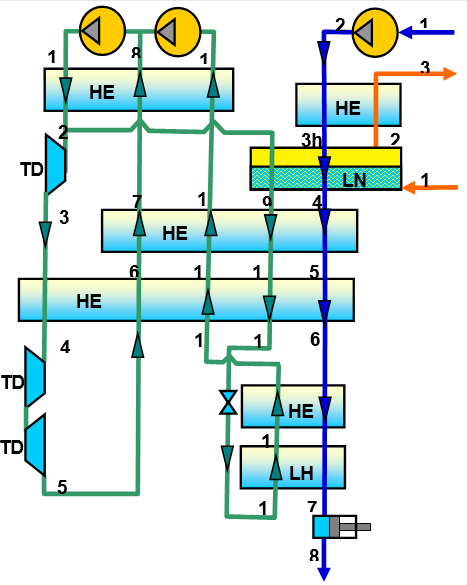THERMODYNAMIC ANALYSIS OF THE CLAUDE CYCLE FOR HYDROGEN LIQUIFICATION
DOI:
https://doi.org/10.15421/jchemtech.v31i3.283742Keywords:
Clean energy, hydrogen, liquefier, refrigeration, thermodynamic losses, entropyAbstract
Thermodynamic methods of reducing energy consumption are the most universal and practical. Therefore, the development of new thermodynamic analysis methods is relevant in the world preparing for the transition to the use of only renewable energy sources. This paper presents a new type of diagram that clearly shows the thermodynamic losses in the apparatuses of cryogenic units. The use of the Q-1/T diagram for the thermodynamic analysis of low-temperature cycles is illustrated on the basis of concrete examples. Based on the given thermodynamic analysis, the areas of improvement of the hydrogen Claude cycle are identified for future hydrogen liquefaction plants with optimized energy efficiency. This work focuses on the application of new methods and innovative concepts, which are either readily available. They will allow the implementation in hydrogen liquefaction plants in the near future.
References
Mazloomi, K., Gomes, C. (2012). Hydrogen as an energy carrier: Prospects and challenges. Renew. Sustain. Energy Rev. 16, 3024–3033.
Staffell, I., Scamman, D., Velazquez Abad, A., Balcombe, P., Dodds, P. E., Ekins, P., Shah, N., Ward, K. R. (2019). The role of hydrogen and fuel cells in the global energy system. Review. Energy Environ. Sci., 12, 463–491.
Mikul, H. (2021). Energy transition and the role of system integration of the energy, water and environmental systems. J. Clean. Prod., 292, 126027.
Yin, L., Ju, Y. (2020). Review on the design and optimization of hydrogen liquefaction processes. Front. Energy, 14, 530–544.
Zhang, T., Uratani, J., Huang Y., Xu L., Griffiths, S., Ding, Y. (2023). Hydrogen liquefaction and storage: Recent progress and perspectives. Renewable and Sustainable Energy Reviews, 176, 113204. https://doi.org/10.1016/j.rser.2023.113204
Krasaein, S., Stang, J. H., Neksa, P. (2010). Development of large-scale hydrogen liquefaction processes from 1898 to 2009. Int. J. Hydrogen Energy, 35, 4524–4533.
Zou, A., Zeng, Y., Luo, E. (2023). New generation hydrogen liquefaction technology by transonic two-phase expander. Energy, 272, 127150.
Aasadnia, M. Mehrpooya, M. (2018). Large-scale liquid hydrogen production methods and approaches: A review. Applied Energy, 212, 57–83. doi:10.1016/j.apenergy.2017.12.033.
Sadaghiani, Mirhadi S.; Mehrpooya, Mehdi (2017). Introducing and energy analysis of a novel cryogenic hydrogen liquefaction process configuration. International Journal of Hydrogen Energy, 42(9), 6033–6050. doi:10.1016/j.ijhydene.2017.01.136
Zhang, S., Liu, G. (2022). Design and performance analysis of a hydrogen liquefaction process. Clean Technologies and Environmental Policy. 24, 51–65.
Decker, L. (2020). Latest Global Trend in Liquid Hydrogen Production, https://www.sintef.no/globalassets/project/hyper/presentations-day-1/day1_1430_decker_latest-global-trend-in-liquid-hydrogen-production_linde.pdf/.
Chang, H. M., Ryu, K. N.; Baik, J. H. (2018), Thermodynamic design of hydrogen liquefaction systems with helium or neon Brayton refrigerator. Cryogenics, 91, 68–76.
Al Ghafri, S. Z., and al. (2022). Hydrogen liquefaction: a review of the fundamental physics, engineering practice and future opportunities. (Review Article). Energy Environ. Sci., 15, 2690-2731. DOI: 10.1039/D2EE00099G
Drnevich, R. (2003). Hydrogen delivery – liquefaction & compression. Praxair, strategic initiatives for hydrogen delivery workshop – May 7, 2003. Available from: https://www1.eere.energy.gov/hydrogenandfuelcells/pdfs/liquefaction_comp_pres_praxair.pdf
IDEALHY – “Integrated Design for Efficient Advanced Liquefaction of Hydrogen”, Website: http://www.idealhy.eu/
Kravchenko, M. B. (2004). Analysis of thermodynamic cycles of low temperature units using q-1/T diagrams. Industrial gases. 2, 43-46. (in Russian)
Kravchenko, M. B. (2011). On the possibility of using a cryogenic cycle with a heat engine for liquefying natural gas. Refrigeration Engineering and Technology. 3 (131), 47-55. (in Russian)
Razani, A., Dodson, C. Fraser, T. (2012). Exergy-based figure of merit for regenerative and recuperative heat exchangers with application to multistage cryocoolers. Advances in Cryogenic Engineering AIP Conf. Proc. 1434, 1830-1838. doi: 10.1063/1.4707120
Maha, R., Marine, T., Florence, D., Jonathan, D., and Marian, C. (2020). Electrochemical hydrogen compression and purification versus competing technologies: Part II. Challenges in electrocatalysis. Chinese Journal of Catalysis. 41, 770–782
Ohlig, K., Decker, L (2014). The latest developments and outlook for hydrogen liquefaction technology. Proc. of the 20th World Hydrogen Energy Conference Gwangju.
Zhuzhgov, A. V., Krivoruchko, O. P., Isupova, L. A. et al. (2018). Low-Temperature Conversion of ortho-Hydrogen into Liquid para-Hydrogen: Process and Catalysts. Review. Catalysis in Industry. 10, 9–19. https://doi.org/10.1134/S2070050418010117

Downloads
Published
Issue
Section
License
Copyright (c) 2023 Oles Honchar Dnipro National University

This work is licensed under a Creative Commons Attribution 4.0 International License.
- Authors reserve the right of attribution for the submitted manuscript, while transferring to the Journal the right to publish the article under the Creative Commons Attribution License. This license allows free distribution of the published work under the condition of proper attribution of the original authors and the initial publication source (i.e. the Journal)
- Authors have the right to enter into separate agreements for additional non-exclusive distribution of the work in the form it was published in the Journal (such as publishing the article on the institutional website or as a part of a monograph), provided the original publication in this Journal is properly referenced
- The Journal allows and encourages online publication of the manuscripts (such as on personal web pages), even when such a manuscript is still under editorial consideration, since it allows for a productive scientific discussion and better citation dynamics (see The Effect of Open Access).

